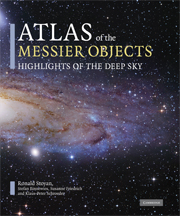Book contents
- Frontmatter
- Dedication
- Contents
- Foreword
- Preface
- User Guide
- Charles Messier
- The Observations
- The Catalog
- Statistics of the Messier objects
- Visual observation of the Messier objects
- Photography of the Messier objects
- The 110 Messier objects
- Glossary of technical terms
- Index of figures
- Index of sources
Statistics of the Messier objects
Published online by Cambridge University Press: 05 August 2015
- Frontmatter
- Dedication
- Contents
- Foreword
- Preface
- User Guide
- Charles Messier
- The Observations
- The Catalog
- Statistics of the Messier objects
- Visual observation of the Messier objects
- Photography of the Messier objects
- The 110 Messier objects
- Glossary of technical terms
- Index of figures
- Index of sources
Summary
When Charles Messier observed the objects that eventually made up his famous catalog, his visual impressions only allowed him to distinguish between “amas d'étoiles” (star clusters) and “nebuleuse” (nebulae). By our modern methods of astrophysics, we can finally classify Messier's objects according to their physical categories. His catalog contains:
• 6 Galactic nebulae
• 28 Open clusters
• 4 Planetary nebulae
• 29 Globular clusters
• 40 Galaxies
• 3 other objects
In this list, M 8 has been counted as an open (star) cluster, because Messier noted the star cluster as the main object. M 16, of which Messier could not see the surrounding nebulosity, is registered as a star cluster, while the nebula has its separate catalog designation (IC 4703). M 20, regarded by Messier as a star cluster like the other two objects, is classified as a galactic nebula today. But in reality, modern classification is still a bit ad hoc. For example, the galactic nebulae M 17, M 20, and M 42 are best known for their dust-enshrouded, young star clusters in the process of formation, only hidden in visual light.
M 45, the Pleiades, is the brightest Messier object with a total magnitude of 1.2. This bright star cluster is visible to the naked eye even under a light-polluted sky. The status of the faintest Messier object is shared by M 76, M 91, and M 98, all at a total magnitude of only 10.1. The largest in angular size of all Messier objects is undoubtedly the Andromeda Galaxy (M 31) at 4° × 1°. Under a very dark, transparent sky, a visual size of as much as 5° has been reported. However, in absolute terms, the galaxy M 101 is the physically largest object of the Messier catalog. With a diameter of 184,000 light-years, it reaches 1½ times the size of our neighbor galaxy M 31 and almost twice the size of our own galaxy.
- Type
- Chapter
- Information
- Atlas of the Messier ObjectsHighlights of the Deep Sky, pp. 53 - 62Publisher: Cambridge University PressPrint publication year: 2008
- 1
- Cited by



